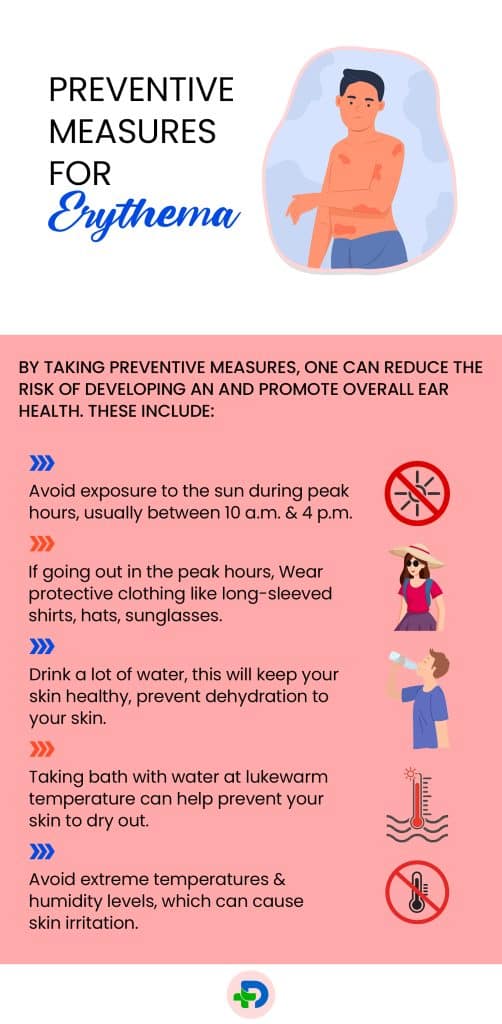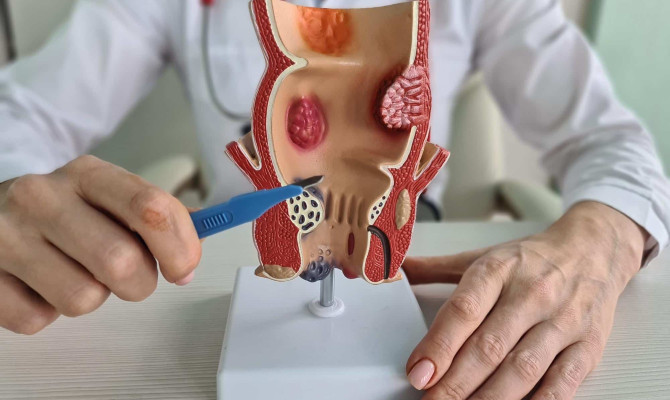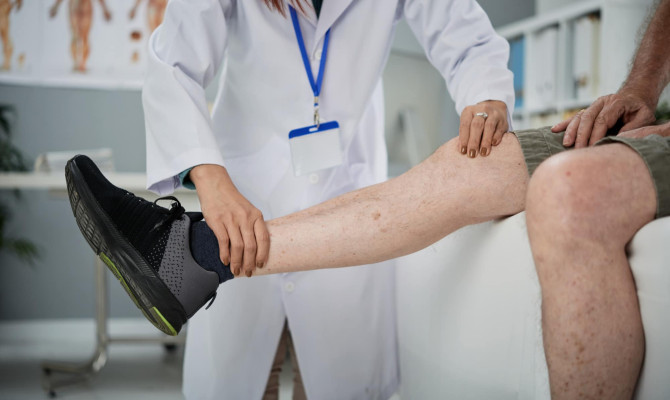Erythema : Causes and Management

- Erythema
- 27 Sep 2023
Overview
What is erythema ?
The broad category of skin conditions known as erythema can affect any part of the skin or mucous membranes, causing an unnatural redness. It typically happens as a result of a sickness, infection, or drug reaction. The rash can range in severity from minor to potentially fatal. Arteriole dilatation, which is thought to take place in deeper tissues where the desired effect is needed, causes the skin to become superficially erythematous. Recurrence is possible and usually lasts between two and four weeks.1Overview| Researched based study from Sciencedirect.com

Types
Types of Erythema
Skin that is red from dilated tiny blood vessels and increased blood flow is referred to as erythema which can appear in a variety of different forms:
Erythema multiforme
- It is a skin condition that causes red, elevated, and often painful skin lesions to suddenly appear. These lesions can resemble rings, targets, or blister-like structures.
Erythema Nodosum
- It is a skin condition that results in tender, swollen nodules that are red and swollen. It frequently affects the arms, thighs, and shins.2Types| Researched based study from Sciencedirect.com
Erythema marginatum
- It is a skin rash with a round shaped pink center along with a red outline that develops on the trunk and limbs. It can also take the form of rings or have larger, more erratic shapes.1Types| Researched based study from Sciencedirect.com
Erythema chronicum migrans
- This skin infection primarily affects Lyme disease patients and manifests as circular bulls-eye rashes on the skin that are at least 5 cm in diameter.
- They typically go away on their own over days or weeks and, while they may feel warm to the touch, they are neither painful nor itchy.
Erythema toxicum neonatorum
- It is a relatively harmless infection that primarily affects newborns. On the face, trunk, or limbs, the red blotches frequently appear with tiny white or yellow pimples.
Erythema Annulare Centrifugum
- It’s a chronic skin ailment that usually affects the trunk or limbs with a ring-shaped rash that gradually spreads outward. They usually appear on the thighs, legs, buttocks, arms, or face.1Types| Researched based study from Sciencedirect.com
Erythema infectiosum
- This skin infection is mostly found to occur in children and Pregnant women due to the presence of parvovirus B19 virus. This virus spreads through nose or mouth.
Palmar erythema
- This skin condition affects the palms of the hands making them red and warm but is neither too itchy nor painful.1Types| Researched based study from Sciencedirect.com
- It is usually caused because of another health condition or could be due to hereditary.
Erythema ab igne (EAI)
- Its a skin condition which results after a prolonged exposure to heat or sunlight, making a fishnet hyperpigmentation pattern with sensation of pain, burning.
Causes
What are the different causes?
Erythema can be developed when the layer of fat under the skin becomes inflamed or irritated. It can be triggered by:
Allergy
- Consuming various medications like antibiotics, anti-seizure drugs, and contraceptive pills one may experience allergic reactions, causing Erythema to develop.3Causes| Researched based study from Healthdirect.gov
Sunburn
- UV radiation from the sun can cause sunburn if you spend too much time outside without protection.
Disorders
- Autoimmune disorders like systemic lupus erythematosus (SLE) can be responsible for erythema to develop.
Infections
- Erythema can be caused by viral, fungal, or bacterial sources of infection
Injury
- Scrapes, cuts, and burns can also be the cause of Erythema to get developed
Hereditary Disorders
- Erythema can be caused by certain genetic disorders, like erythropoietic protoporphyria or hereditary angioedema.
Symptoms
Symptoms of erythema
There are several symptoms associated with Erythema which involve:
Redness
- The skin develops redness, which could be patchy or have a certain pattern, depending on the type of erythema.1Symptoms| Researched based study from Sciencedirect.com
Rash
- The skin has raised bumps or a rash accompanied by itching or pain.
Inflammation
- Inflammation and increased blood flow may cause a warm sensation in the area that is affected.
Blistering
- Erythema can signal its presence by causing Blistering, which is characterized by the formation of fluid-filled sacs on the skin.
Fever
- A more serious infection or condition can be indicated by the development of a fever in a person.
Diagnosis
Diagnosing erythema
Diagnosis of erythema includes a detailed checkup. The steps in the diagnostic process are:
- Enquire: The specialist may ask about the redness and whether any particular locales of the body have been affected, as well as whether he/she has experienced any tingling or inconvenience.
- Physical Observation: Swelling, hasty, and redness will be looked at and carefully observed by the specialist.
- Blood tests: The specialist may take blood tests to search for any underlying illnesses or infections.
- Allergy testing: The allergen may be determined through allergy testing if there is a suspicion that the erythema is caused by an allergic reaction.
- Biopsy: If the cause of the erythema is unclear, the doctor may take a small sample of skin for analysis under a microscope.6Diagnosis| Researched based study from Sciencedirect.com
- Imaging tests: Deeper tissue involvement can be detected through imaging tests like X-rays or CT scans, though this is uncommon.
Therefore, the evaluation of the patient’s medical history, physical examination, and, if required, additional tests are all necessary for the diagnosis of erythema to identify the underlying reason for the redness.
Treatment
Treatment strategies for erythema
The treatment for erythema depends on the underlying cause and type of erythema. Here are some common treatments for erythema:
Ointments
- The doctor may recommend topical creams or ointments like corticosteroid creams, or antifungal creams to reduce inflammation, relieve itching, or promote healing.
Oral medications
- Oral medications/antibiotics may be necessary to treat erythema to relieve itching, and to treat bacterial infections.4Treatment| Researched based study from Clevelandclinic.org
Surgery
- Surgery may be required to treat erythema, in case if it is caused by a skin tumor.
Homeopathic remedies
- Based on the symptoms, homeopathic remedies such as Calendula, Rhus Toxicodendron, and Sulphur may be considered for the treatment of erythema
Light therapy (Photo therapy)
- Exposing the affected region to UV light is a technique used for treating certain types of erythema, known as light therapy.
- Aiding in the reduction of inflammation and acceleration of the healing process, UV light is proficient in this area.
Lifestyle modifications
- Symptoms of erythema may be alleviated with certain lifestyle changes.
- Practicing good hygiene to prevent infection and avoiding exposure to particular allergens or chemicals can contribute to this.
Diet
- Flavonoids such as catechin, quercetin, hesperidin, and rutin can be taken in the dry state or added to your fruit diet.5Treatment| Researched based study from Mountsinai.org
- Herbs such as Aloe Vera, burdock root, calendula, goldenseal, lemon balm, sage extract, slippery elm, and yarrow may aid in the healing of damaged skin, and the promotion of lymph circulation.
Prevention

Preventive Measures
By taking preventive measures, one can reduce the risk of developing an and promote overall ear health. These include:
- Avoid exposure to the sun during peak hours, usually between 10 a.m. and 4 p.m.4Prevention| Researched based study from Clevelandclinic.org
- If going out in the peak hours, Wear protective clothing like long-sleeved shirts, hats, sunglasses.
- Use sunscreen that has a Sun Protection Factor (SPF) of at least 30, and reapply every two hours, if staying outdoors for most of time.
- Drink a lot of water, this will keep your skin healthy, prevent dehydration to your skin.
- Taking bath with water at lukewarm temperature can help prevent your skin to dry out.
- Use gentle skincare products and avoid harsh chemicals that contains sulfates or parabens that can affect the skin.
- Avoid extreme temperatures and humidity levels, which can cause skin irritation.
Side effects
Post-Side effects of treatment
The possible post-treatment side effects of erythema can vary depending on the type of treatment received. Some common post-treatment side effects include:
- It’s found that for people who take treatments like Surgery or Laser Therapy, the treated area usually gets swollen and sometimes can cause scarring.
- Laser therapy & chemical peels, can cause changes in skin pigmentation resulting in darkening and lightening of the skin in the treated area.
- There can be a chance of breaking of the skin which can increase the risk of infection in the form of discharge.
- Certain treatments & medications may cause allergic reactions like itching, hives, and difficulty breathing.
- Undergoing treatment like surgery or laser therapy, can damage nerves in the treated area. which results in numbness, and tingling.
- Skin creams and ointments, as well as laser surgery, can also lead to pain, redness, and skin irritation.
Complications
Possible Complications of not getting Treatment
If erythema is not properly treated, it can lead to several complications, including:
Skin rashes
- Constant rubbing and scratching of the affected area can produce scarring and skin breaches, which can serve as entrance points for bacteria that cause skin infections.
Psychological effects
- Erythema can be a reason for your mental health disturbance which can imbalance your mental -wellbeing which may lead to anxiety and depression.
Systemic complications
- If Erythema is not treated ,it may take shape into a systemic disease, like lupus, rheumatoid arthritis, or even cancer.
Prognosis
Prognosis of erythema
The prognosis for erythema depends on the condition and the stage it is. Usually it resolves on its own or do not require treatment. For example, erythema multiforme resolves within a few weeks but if left untreated it can lead to a more severe form called Stevens-Johnson syndrome which can be life-threatening.7Prognosis | Researched based study from Hopkinsmedicine.org While, Erythema migrans too get resolved within a few weeks but if left untreated, it can take a severe form of Lyme disease. Overall, the prognosis is generally good if it is promptly diagnosed and treated, but its important to talk to the doctor or the concerned dermatologist if you find any changes in your skin.
Any feedback on this article?
 This Articles content was accurate
This Articles content was accurate Very Informative Article
Very Informative Article I have a question or a comment
I have a question or a comment
 This article contains inaccurate content
This article contains inaccurate content This article was not helpful
This article was not helpful I have a question or a comment
I have a question or a comment
We appreciate your helpful feedback!
Checkout our social pages
References
-
Science Direct
Non-Neoplastic Disorders of Pigmentation | Overview | Types | Symptoms
-
Science Direct
The Hypersensitivity Syndromes | Types
-
Health Direct
Erythema nodosum | Causes
-
Cleveland Clinic
Erythema Multiforme | Treatment | Prevention
-
Mount Sinai
Erythema | Treatment
-
Science Direct
Diffuse or Reticulated Erythema | Diagnosis
-
Johns Hopkins Medicine
Erythema Multiforme | Prognosis





































